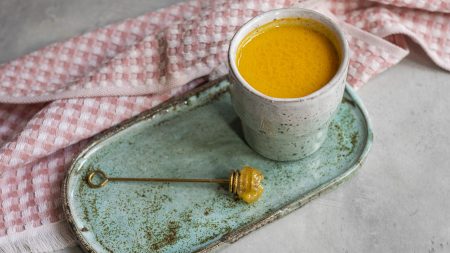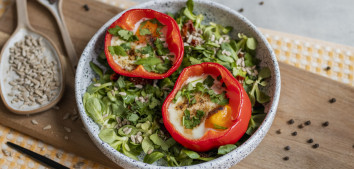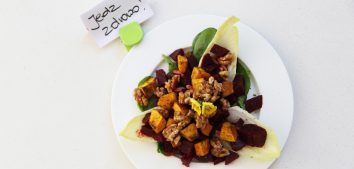
Turmeric: the Queen of Spices?
Turmeric is one of my favorite spices. I appreciate it not only for its health-promoting properties, but also for its versatility and extremely intense, natural color. If you use the Diet & Training by Ann application (HERE), you have probably seen recipes with the addition of turmeric in your menu more than once. This is an ingredient that we also use in Foods By Ann products (HERE), such as Carrot & Orange Smoothie, Ananas & Acerola Smoothie, or Indian Vegetable Paste. Is turmeric the real queen of spices…? 🙂
What is Turmeric?
Turmeric is one of the most popular spices and is also the basic ingredient of curry. It is used primarily in Asian cuisine but is also popular in our country.
It is a rhizome from the ginger family. The most valuable substances (from the health-promoting point of view) contained in turmeric are the so-called curcuminoids – especially curcumin. Curcumin is believed to have the most health-promoting properties. It belongs to polyphenols, i.e. compounds that are
- antioxidative,
- anti-inflammatory,
- anti-cancer.
The Properties of Curcumin
Curcumin and the Metabolic Syndrome
Metabolic syndrome is the co-occurrence of several risk factors that significantly increase such problems as the risk of cardiovascular diseases or type 2 diabetes. These factors include: obesity, hypertension, carbohydrate metabolism disorders (prediabetes, type 2 diabetes) and lipid metabolism (increased non-HDL cholesterol). Studies show that curcumin may be helpful in metabolic syndrome because it improves insulin sensitivity and lipid profile, inhibits the formation of new fat cells, and helps reduce blood pressure, inflammation and oxidative stress. It is worth remembering that excess weight and obesity are closely related to chronic inflammation of varying severity, which cannot be ignored, and that is why it is even more important to include anti-inflammatory substances in the diet.
Curcumin and the Circulatory System
The healing potential of curcumin has also been demonstrated in the field of cardiovascular diseases, especially atherosclerosis, which is a multi-stage process involving the development of atherosclerotic plaques. Curcumin supplementation had a positive effect on the lipid profile. Researchers assume that this is the result of the anti-inflammatory effect of curcumin and its ability to participate in some signaling pathways directly related to the development of atherosclerosis.
Fatty Liver Disease Associated with Metabolic Disorders
This complicated-sounding disease (abbreviated as MAFLD – metabolic dysfunction-associated fatty liver disease) is an increasingly common condition involving non-alcoholic fatty liver disease (the fat content in liver cells exceeds 5% of the total weight of the organ). According to some data, MAFLD may affect up to ¼ of the population! The risk of MAFLD is increased in people with obesity and/or type 2 diabetes, but the disease may also affect people with normal body weight. The development of MAFLD has been associated with oxidative stress, damage to lipids, proteins and DNA. It has been proven that curcumin can inhibit these processes and be part of therapy, although further research is needed to determine the specific supplementation dose of the substance in question.
Curcumin – the Endless Potential?
Considering the antioxidant and anti-inflammatory properties of curcumin, it is easy to guess that many scientists have become interested in it. Research into its health-promoting and healing potential is still ongoing. Its use is analyzed e.g. in neurological diseases, inflammatory bowel disease, PCOS or respiratory system. I believe that the coming years will provide us with a lot of promising data, which I will definitely follow and share with you.
Supplement or Spice?
As I have already mentioned, the curcumin contained in it is responsible for most of the valuable properties of turmeric. Unfortunately, by consuming turmeric in powdered form or using fresh rhizome, we are not able to obtain such large amounts of curcumin as used in research. Moreover, the bioavailability of curcumin is influenced by many factors, including individual ones (such as the composition of the intestinal microbiota). Therefore, it is difficult to determine how much curcumin our body will use when we enrich our diet with turmeric. However, it is worth knowing that the piperine contained in black pepper increases the bioavailability of curcumin by up to 2000%! So combine pepper and turmeric as often as possible.
Summary
I think you no longer have any doubts that turmeric has great potential. Even though using the spice we are not able to obtain doses of curcumin identical to those used in supplements, I still believe that it is a great idea to enrich your dishes with it – especially for preventive purposes. Its antioxidant and anti-inflammatory properties will be useful not only in autumn and winter. Moreover, I would like to remind you that turmeric is a great, natural dye that will add this sunny pop of color to your dishes, which is yet another point on the list of its benefits! 🙂
Bibliography
- Alan Jiang T, Health Benefits of Culinary Herbs and Spices, Journal of AOAC INTERNATIONAL, Volume 102, Issue 2, 1 March 2019, Pages 395–411. doi: 10.5740/jaoacint.18-0418
- Ciba-Stemplewska A, Gorczyca-Głowacka I. Praktyczne aspekty diagnostyki stłuszczeniowej choroby wątroby związanej z zaburzeniami metabolicznymi. Lekarz POZ. 2023;9(3):155-162
- Dobrowolski P, et al. Zespół metaboliczny – nowa definicja i postępowanie w praktyce. Stanowisko PTNT, PTLO, PTL, PTH, PTMR, PTMSŻ, Sekcji Prewencji i Epidemiologii PTK, „Klubu 30” PTK oraz Sekcji Chirurgii Metabolicznej i Bariatrycznej TChP. Lekarz POZ. 2022; 8(3)
- Jabczyk M, et al. Curcumin in Metabolic Health and Disease. Nutrients. 2021 Dec; 13(12): 4440. doi: 10.3390/nu13124440
- Pulido-Moran M, et al. Curcumin and Health. Molecules. 2016 Mar; 21(3): 264. doi: 10.3390/molecules21030264
- Różański G, et al. Curcumin and Biochemical Parameters in Metabolic-Associated Fatty Liver Disease (MAFLD)—A Review. Nutrients. 2021 Aug; 13(8): 2654. doi: 10.3390/nu13082654











Comments No Comments
Join the discussion…